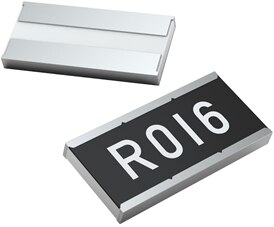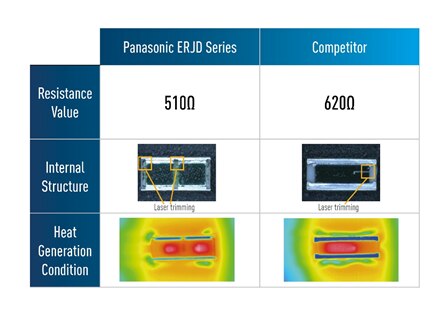A higher level of power in smaller parts – this is undoubtedly the overriding direction where the electronic component market is currently heading.
That also applies for resistors, being the smallest and most accessible components in any electronic design. When looking, for instance, at a standard resistor in 1206 case size with a power range of 0.25W, there is a constant demand from the market to achieve this range in a case size not larger than 0603.
For established suppliers of high quality resistors like Panasonic, this means to continuously strive for innovation in order to meet the customers’ demands for a contemporarily advanced resistor portfolio.
Image 1: Construction of Panasonic Industry wide terminal resistors
Panasonic Industry's blueprint for meeting those resistor downsizing requirements would be the wide terminal resistors.
The name is based on two innovative constructive principles:
First, the terminals on this type of resistor are found on the long side of the resistor whereas they are on the short one at conventional products (cf. image 1).
So, when having conventionally a 2010 case size, the wide terminal type would be correspondingly 1020 case size. This increases the amount of current being able to pass through the resistor which results in a significantly higher power range.
Second: Instead of using one block of resistive element, two or three blocks are used. Each of these smaller elements is trimmed by laser. This supports the heat dissipation throughout the alumina substrate elements and avoids hotspots in one area, as illustrated in image 2.
Image 2: Heat generation in Panasonic wide terminal resistors vs. conventional wide terminal resistors
As a result, the power range can be increased. Depending on the case size of the wide terminal resistor types, they contain two or three resistive elements.
Panasonic Industry wide terminal resistors with lower resistance values are particularly popular for replacing metal shunt resistors. If the replacement is technically feasible, resorting to these resistors helps saving space on the PCB.
Last but not least, wide terminal resistors are much cheaper compared to metal shunt resistors, rendering them the perfect solution for current sensing with higher power requirements.
The field of suitable applications for wide terminal resistors is wide: From automotive and industrial applications to building automation and many other applications where a higher power range is as essential as a compact case design.
In the automotive sector, wide terminal resistors can be used in electrical control units (ECU), anti-lock braking systems, headlights, EPS, motors and many other applications whereas in industrial contexts, wide terminal resistors are the perfect solution for power supplies, DC/DC converters or motor controls.
Whilst mostly focusing on low ohmic values, Panasonic Industry wide terminal resistors are available in three different categories: the conventional type with the widest range as ERJA/B series, anti-sulfur wide terminal resistors as ERJC and low TCR type as ERJD series.
Get a glimpse on the following overview on the company’s wide terminal resistor series – and keep them in mind if you are looking for a new resistor meeting your downsizing needs without any compromises in terms of power handling.
Series | Description | Resistance range | Power range |
ERJA/B | current sensing and conventional wide terminal resistors | 5 mΩto 1 MΩ |
|
ERJC | current sensing and anti-sulfur wide terminal resistors | 10 mΩ to 1 Ω | 2 W |
ERJD | current sensing and low TCR wide terminal resistors | 10 mΩ to 200 mΩ | 1-2 W |


